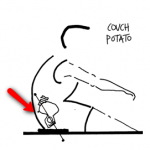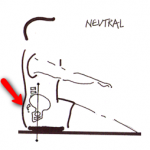Good posture is the foundation of a good stroke. When you have good posture everything seems easier and you will simply be able to move better. You will be able to use your large muscle in a wider range of motion and you will be poised, ready, and able to generate more power through your legs, hips, and core to accelerate the boat.
Think about how you sit.
Couch-potato posture
Try sitting in the “couch-potato” position (say while watching TV). Here is what I notice:
- My tailbone is tucked under and there is a curve in my lower back – I feel a slight strain
- My belly is it extended out, right around my hip area
- My chin is down toward my chest
- When I reach forward, I feel tension in my shoulders
- When I extend my reach by moving at the hips, I can really feel the curve in my back and tension in my shoulders
Dancer posture
Try sitting up nice and tall like a dancer and notice how things change. This is what I notice:
- My tailbone is in line with my hips and the is a curve and strain in my lower back is gone
- My belly is sucked in as I engage my abs to sit tall
- My chin is up, my chest is up and out and my shoulders are back
- I can reach forward without feeling tension in my shoulders
- I can move forward easily from the hips without feeling tension or strain
Be a dancer
When you sit in the boat, or on the erg, think about your posture and sit more like a dancer and less like a couch potato. If all rowers in the boat sit and move in the same way, you will be able to:
- Have good boat balance – no tension in the body and identical movements
- Start the stroke long – staying tall allows a good body forward angle and square upright shoulders allow good rotation toward the pin
- Have clean catches – no tension in the shoulders allows for easy un-weighing of the handle at the catch
- Transfer power effectively during the drive with more body and blade control
- Finish the stroke long with good boat balance at the finish
Working on your rowing posture
Use the following checklist when working on your posture. You can ask a friend to check the list while you row or you can video tape yourself. Using a drill like a pause drill or the pick drills can help you feel good or bad posture in each position.
| Rowing Posture and Position Checklist | Yes/No |
|---|---|
| At the finish: | |
| feet are pressing against the footboard | |
| feet, ankles, knees and hips are all in line, not buckling in or bowing out out | |
| bum bones are pointed down | |
| hips bones are behind the bum bones and pointing forward | |
| back is straight with the shoulders behind the hips | |
| low back is supported with the core engaged | |
| hands are loose on the handle to keep the shoulders relaxed and the chest up and lungs open | |
| shoulders are behind the hips, down, and relaxed | |
| During the recovery: | |
| hips close in toward the thighs and move in front of the bum bones | |
| shoulders move in front of the hips | |
| back should be nice and flat and you are sitting up tall | |
| your hands, shoulders and hips should form a triangle | |
| knees come up to the chest | |
| your hands and torso should not move once they are set; the triangle should not change | |
| The catch position: | |
it is important to keep your shoulders up and your lower back supported
|
|
| this is where poise comes in – you must be relaxed but ready in the catch position to lock the blade in and drive off a solid platform | |
| Drive position: | |
| your arms stay straight and do not grab or pull | |
| shoulders and head stay steady and relaxed | |
| your arms, shoulders, and head do not do the active work. Rather, they take the load from the legs and hip flexors to move the boat | |